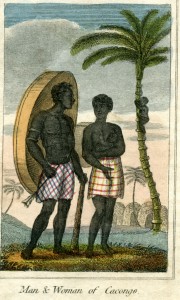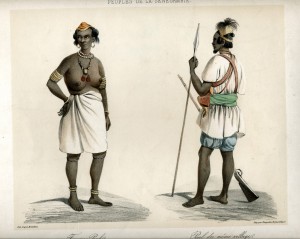African Print Collection

The African Print Collection is made up of 230 colored and black and white engravings that William Loren Katz collected. Read below for detailed descriptions of the images. The Collection is available for purchase by contacting his wife, Laurie R. Lehman at lehmannyc@aol.com.
For more than forty years as he researched and wrote 40 highly praised books on African American history, William Loren Katz traveled all over the world. In Europe,
the Caribbean, Africa and the United States, his research also led him into print shops where his historian’s eye selected fascinating antique engravings of African scenes. These rare representations of African life date from the early sixteenth century to the late nineteenth century and are now offered for sale as the “African Print Collection.”
Sketched by European artists, the representations in the “African Print Collection” depict African village scenes during the 17th and 18th centuries, providing a rare look at the way people lived and worked, at African royalty and class distinctions, and at the myriad social roles undertaken by African men and women in various parts of the continent during the centuries.

They cast new light on African customs and mores and depict the way rulers conducted diplomacy and waged war. Most engravings show how ordinary people worked in crafts, farm labor and at various trades, how they managed family affairs, and how they viewed their monarchs and their lives. Most engravings in the “African Print Collection” are in black and white, but some are in color. For preservation more than a hundred images have been professionally mounted on 16″ by 20″ 2-ply museum board. Each board is in a polyethylene bag, and the collection is housed in a 16″ by 20′ acid free print box.
The “African Print Collection” recently acquired another hundred plus engravings—including stark contemporary representations of the infamous slave trade. The additions, many in color, dramatically enhance three centuries of the story of African peoples and deepen the substance of the continent’s cultural development. The total collection therefore currently amounts to two hundred and thirty engravings. Viewing by appointment only: e-mail lehmannyc@aol.com.

“Wonderful collection . . . very important and impressive.”
— Cora Michael, Assistant Curator, Department of Drawings and Prints, The Metropolitan Museum of Art, New York
“As Director of Africana Studies at Bard College and an anthropologist who does research in Ghana and South Africa on performance and popular culture, I am writing
regarding a unique collection of etchings and hand colored engravings of Africa. It is owned by the African American historian William L. Katz, who collected them as a side project to his main collection of African Diaspora images over the course of 50 years of travel. It is an amazing and unique collection of approximately 230 images from the 17th-19th centuries. They cover a range of themes from European contact to African Christianity to European images of African bodies, cultures and spaces. Mr. Katz wants to sell this collection but wants to be sure it ends up with either an institution or a private collector who will understand the historic importance of this work. As an anthropologist, I feel invested in being sure that the collection is maintained as it is rather than being sold piece by piece, losing its historical significance.”
— Jesse Weaver Shipley, John D. Willard Professor of African and African American Studies and Oratory, Dartmouth College; previously professor at Bard College.